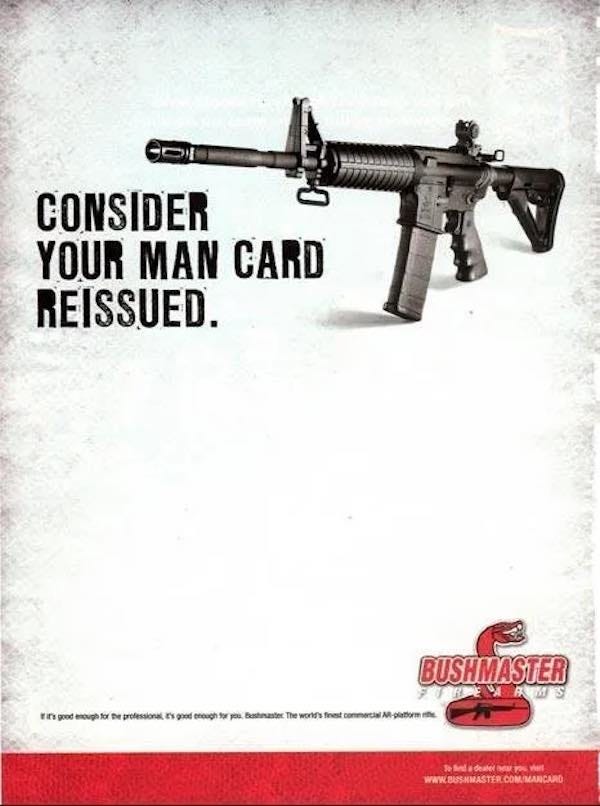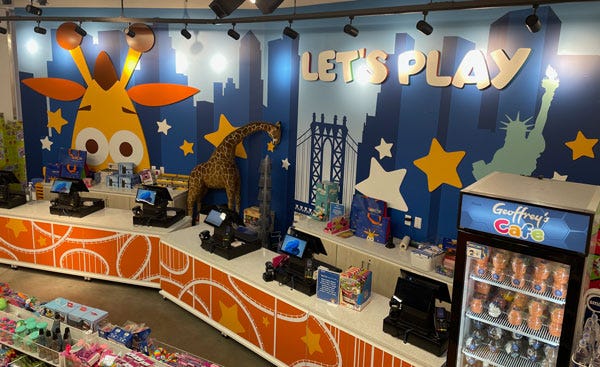Wednesday Walk: Guns and Ships
Toy guns for sale where they're not supposed to be, A retailer takes to the sea
Welcome to Willoughby Hills!
If you enjoy what you’re reading, please consider a free subscribtion to receive emails every Wednesday and Sunday plus podcast episodes every two weeks. There are also paid options, which unlock even more features.
As is typical every Wednesday, I’m bring you a smattering of topics that I hope will make you a bit more curious about the world around you and give you something to think about later. I call these Wednesday Walks, as it’s the type of conversation we might have walking down a path in the woods. Shall we take a stroll?
Boys Being Boys?
I wanted to open today with an image that I first shared on Instagram.
In case you’re not familiar, that’s a replica of an AR-15 style rifle and it’s selling in the toy aisle at my local Wal-Mart, directly next to Sesame Street finger puppets. The box is labelled for ages 5 and up. The gun makes sounds, lights up, and vibrates. It also comes with a detachable silencer.
I had so many emotions when I happened upon this toy over the weekend. I was disgusted at the thought of a five year old playing with a fairly realistic version of the rifle that was used to murder kindergartners and first graders at Sandy Hook Elementary School. I was also saddened by the thought of Tamir Rice being shot by police at age 12 for playing with a toy pistol in a park. The presumably white parents that are buying these AR-15s for their white children don’t have to worry about how their sons will be perceived holding this gun. They won’t be viewed as criminals or shot without explanation. That’s not the same reality for Black and Brown children.
Wal-Mart stopped selling assault style rifles in 2015 and in 2018 amended their policy to include this (emphasis added):
“We are also removing items from our website resembling assault-style rifles, including nonlethal airsoft guns and toys. Our heritage as a company has always been in serving sportsmen and hunters, and we will continue to do so in a responsible way.”
I’m not quite sure what to make of this.
Perhaps a part of my anger also came from recently reading the new book American Gun: The True Story of the AR-15, co-written by Wall Street Journal reporters Cameron McWhirter and Zusha Elinson. I’ve been trying to book McWhirter and Elinson as guests on the podcast and am hoping that can still happen because their book is really incredible.
American Gun is a meticulously reported cultural history of one of the most popular weapons in America. It begins in the 1950s in a Los Angeles garage, where inventor Eugene Stoner is looking to build the perfect military grade weapon. At the time, conventional thinking was that military weapons should use larger caliber bullets and be able to be fired for accuracy.
Stoner’s innovation was using smaller bullets that were shot with a more erratic trajectory. When they hit flesh, they essentially spin out of control, causing massive damage to the victim. Stoner also thought that firing faster was more important in combat than firing accurately. Most soldiers shoot scared and don’t spend a lot of time aiming their weapon, so being able to fire a torrent of bullets is seen as a military advantage.
The AR-15 was considered a tactical gun for professional soldiers until the late 1990s and early 2000s. The few in consumer hands at the time were at the fringe of gun culture- mainstream hunters and NRA members saw them as an outlier.
Advertising for the AR-15 in the 2010s helped mainstream the firearm, appealing especially to young males with ads like the above published in places like Maxim. AR-15 sales went through the roof, but the gun also became the weapon of choice for many mass shootings.
Perhaps I’m reading too much into it, but it seems to me that the toy gun in the aisle at Wal-Mart as a continuation of the strategy above, but trying to capture an ever younger market. It reminds me of the tobacco company strategies of using cartoons like Joe Camel or new products like flavored vape pens to appeal to younger people, even people who can’t legally buy the product advertised.
I am disappointed in Wal-Mart for not keeping their pledge to remove these toys from the shelf. As I said on Instagram, there’s a lot about America to unpack in that single toy on a single shelf.
Speaking of Toys…
If you’ve been reading this newsletter for any length of time, you know that I am a fan of Toys R Us. My first real job was working as a cashier at the toy retailer, and I’ve written about the Toys R Us branded stores within Macy’s and even visited the Toys R Us stores that are still in existence in Canada.
For those of you who don’t keep up with the toy beat, let me catch you up. Toys R Us currently operates one location, inside of the very bizarre American Dream mall in East Rutherford, NJ. They also have Toys R Us storefronts located within Macy’s department stores.
Well, it turns out Toys R Us will soon be expanding. According to CNBC, they plan to open up to 24 flagship stores across the U.S., while also expanding into airports and cruise ships.
The former makes perfect sense. As I’ve said nearly anytime I write about the former toy giant, even though they have lost nearly all of their physical retail space, they still have a tremendous amount of brand equity. This new strategy feels like the glory days of FAO Schwarz, which at one time also had a handful of flagship stores across the U.S. (including here in Boston). Their Fifth Avenue location in New York became iconic after the 1988 film Big filmed in the store, although FAO ended up closing all of their stores before opening a new flagship in Rockefeller Center. (They were also owned by Toys R Us for a few years).
As for airports and cruise ships, I’m less convinced.
When I visited a Toys R Us store in Ontario over the summer, I wrote this:
“While there are advantages to buying a bike or stroller in person, there’s hardly a case to be made for making the trip to Toys R Us for Monopoly, a Barbie doll, or a Lego set. These can be ordered online more conveniently (and likely for less money). They can be purchased at Target or Wal-Mart while also buying toilet paper and cleaning supplies.”
I feel like this problem becomes even more pronounced when you’re in a situation like an airport of cruise ship. A small toy for travel may be a worthwhile purchase- a deck of cards, a travel game, a stuffed animal. But board games, Lego sets, Barbie dream houses, or many of the other items Toys R Us sells are simply too bulky for it to be worthwhile to drag through an airport or stash in the tight quarters of a cruise ship room.
Maybe I’m wrong and these concepts will simply be a licensing deal with a Toys R Us logo over what would normally be a regular gift shop.
The first airport location is scheduled to open at Dallas-Fort Worth International Airport in November. Sadly, I’m flying through that airport next week and won’t be in time for the grand opening. Maybe I’ll at least be able to see the backwards R sign hanging in the terminal, near a Cinnabon or Hudson News before it makes its grand debut. Stay tuned for more…
No Podcast This Week
Due to some other scheduling conflicts, there will be no new podcast episode this week. I’ll be back with a new show in two weeks.
This is a good time to catch up on past episodes of the pod- there’s more than 100 to choose from covering everything from the entertainment industry to agriculture to social media to racial justice. Enjoy!
I publish new issues every Wednesday and Sunday. Sign up to always receive the latest issue and support my work:
Other Wednesday Walks
If you’ve missed past issues of this newsletter, they are available to read here.










